Airfix 1/48 Sea Vixen FAW.2
|
KIT #: |
10106 |
|
PRICE: |
$47.00 plus shipping from HLJ |
|
DECALS: |
Four options |
|
REVIEWER: |
Tom Cleaver |
|
NOTES: |
Xtradecals used |
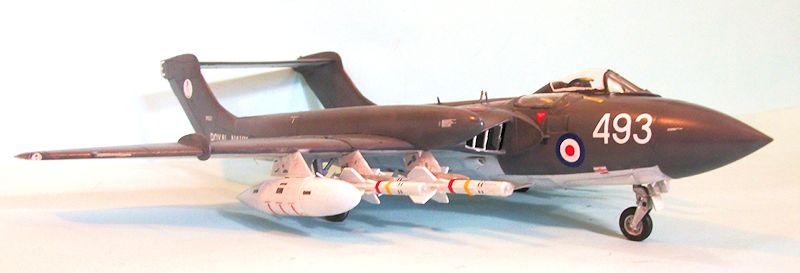
In 1947, the
Royal Navy promulgated a specification for a fleet defense fighter at the same
time that the RAF issued a similar requirement.
De Havilland viewed the requirements as being so similar
that a single aircraft could fulfil both.
Gloster aircraft responded to the RAF requirement with
the GA.5, which would later become the Javelin, while de Havilland responded
with the DH.110.
While RAF liked the Gloster aircraft
five DH 110s were contracted for as insurance, plus four
for the Royal Navy. The four naval DH 110s were canceled when Their Lordships of
the Admiralty decided a simpler and cheaper option would be an improved version
of the de Havilland Sea Venom, the standard model of which was about to enter
service. The five RAF aircraft were cut to two prototypes.
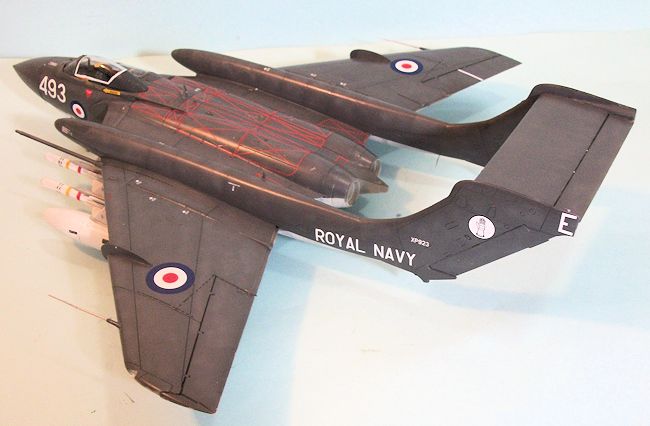 Gloster’s GA.5 was first to fly, and RAF interest in the
DH.110 ended.
De Havilland continued working on the prototypes, the first of
which flew on September 26, 1951. A year later this
aircraft starred in a spectacular accident at the
Farnborough Air Show when the wing failed and the aircraft came apart during a
rolling pull‑up maneuver that killed John Derry, his observer Tony Richards and
29 in the audience.
Following the accident,
the surviving prototype was strengthened and redesigned
over the course of a year before trials continued.
Gloster’s GA.5 was first to fly, and RAF interest in the
DH.110 ended.
De Havilland continued working on the prototypes, the first of
which flew on September 26, 1951. A year later this
aircraft starred in a spectacular accident at the
Farnborough Air Show when the wing failed and the aircraft came apart during a
rolling pull‑up maneuver that killed John Derry, his observer Tony Richards and
29 in the audience.
Following the accident,
the surviving prototype was strengthened and redesigned
over the course of a year before trials continued.
With the cancellation of the improved Sea Venom project,
the FAA decided they were interested in the DH 110 after all.
WG240, the second prototype, successfully underwent
carrier trials.
The airplane was significantly redesigned to create the DH.110
Mk.20X prototype for a production version to be designated the FAW 20. Ten
development aircraft were ordered in 1955; the first was the Mk.20X, which had
no folding wings and first flew on June 20, 1955. Trials went well and 35
additional airframes were ordered. The first full FAW.20 flew on March 20, 1957.
The initial specification called for four Aden cannon
and four Firestreak missiles, but this was changed to an all-missile armament
with unguided air‑to‑air rockets in pop-out boxes fitted in place of the cannon.
The first FAW 1 was delivered in November 1957 to 700
Squadron, which formed a trials unit and tested eight FAW 1s until the unit was
re‑comissioned as 892 squadron.
The side‑by‑side seating of the Sea Venom was kept in an unusual form, with the
observer seated below and to the right of the pilot in a cockpit known as “the
coal‑hole” because of almost total lack of a view out of it; it was not a
popular arrangement.
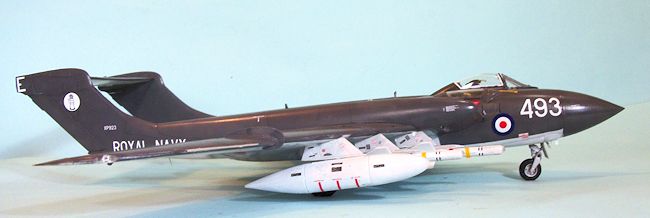 At the time
of its introduction, the Sea Vixen attracted foreign interest, including West
Germany and Australia.
De Havilland was working on an improved with thin wings
when the British decided manned aircraft were obsolete in the 1957 Defense White
Paper.
Foreign interest evaporated and the supersonic version was canceled.
At the time
of its introduction, the Sea Vixen attracted foreign interest, including West
Germany and Australia.
De Havilland was working on an improved with thin wings
when the British decided manned aircraft were obsolete in the 1957 Defense White
Paper.
Foreign interest evaporated and the supersonic version was canceled.
Another proposed improvement was a version with
increased fuel in wing tip tanks and an extended forward fuselage, which never
got off the drawing board.
Improvement went to the FAW 2 version which entered
service in 1963.
It featured enlarged tail booms which extended forward of the
wing leading edge, giving give more room for ECM equipment in the top half and
additional fuel in the tip and bottom.
The missile armament was changed to the Red Top, which
had limited all‑aspect seeker heads and Bullpup air‑to‑ground missile
capability, as well as an alternative ground attack armament of 4 24-rocket SNEB
pods.
The obsever’s hatch, which was flat with a small window in the FAW 1 was
made fully clear and bulged; it was additionally possible for the observer to
eject through this frangible hatch, which had not been possible in the earlier
version.
If the seat failed to fire, this meant the observer had to try and
escape through the clear part of the hatch, which was a very tight fit. In one
sad case, an observer got stuck half way out and despite frantic efforts by his
pilot to free him, ended up being killed.
While the Sea Venom never saw combat, it did take part
in the military emergencies of the 1960s.
When Iraq threatened to invade Kuwait in 1961, HMS
Victorious transferred from the South
China Sea to the Persian Gulf while HMS Bulwark
landed marines in Kuwait. Sea Vixens patrolled the skies, and Iraq stepped back
from invasion.
In January 1964, Sea Vixens from HMS Centaur flew air
cover for marines landed to support the government in Tanganyika and
provided protection for RAF transports bringing supplies
and equipment.
Unfortunately, the 1966 Defense White Paper canceled the
hoped‑for new carrier CVA‑01, on grounds that carriers were now obsolete.
The obsolete force proved its worth following Rhodesia’s
declaration of independence, when Sea Vixens were deployed to replace Javelins
that proved incapable of operating in the region. The Sea Vixen’s final mission
was providing cover for the withdrawal of
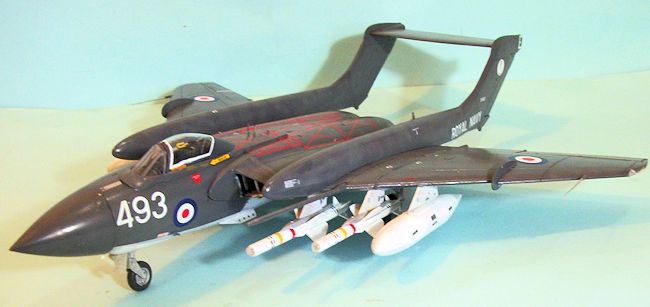 British
forces from Aden in 1967. Sea Vixens of 893 Squadron operated on HMS Victorious
during her epic far east cruise from 1965 to 1967 (Yours truly saw Victorious
and her Sea Vixens at Singapore shortly before my return to the United States
and return to civilian life).
The last Sea Vixen squadron was disbanded in 1972.
Several Sea Vixens were modified to D.3 missile target
drones, but were too expensive for such work and were used to train drone pilots
in flying aircraft by remote control.
Only five D.3 conversions were completed.
One has been restored for flight as G-CVIX and is a
regular airshow performer, the most complex civilian‑operated type on the UK
register until Vulcan XH558 was returned to the air.
British
forces from Aden in 1967. Sea Vixens of 893 Squadron operated on HMS Victorious
during her epic far east cruise from 1965 to 1967 (Yours truly saw Victorious
and her Sea Vixens at Singapore shortly before my return to the United States
and return to civilian life).
The last Sea Vixen squadron was disbanded in 1972.
Several Sea Vixens were modified to D.3 missile target
drones, but were too expensive for such work and were used to train drone pilots
in flying aircraft by remote control.
Only five D.3 conversions were completed.
One has been restored for flight as G-CVIX and is a
regular airshow performer, the most complex civilian‑operated type on the UK
register until Vulcan XH558 was returned to the air.
The Sea Vixen was a tough airplane.
Most famously a Sea Vixen made a bad landing, hitting
several parked aircraft and other deck gear, yet still managed to stagger back
into the air and make a successful landing ashore, minus 8 feet of the right
wing.
While not an air-superiority fighter, it had good maneuverability and
was supersonic in a dive.
The Sea Vixen equipped two FAA flight demonstration
teams: “Simon’s Sircus” named after the team leader, LCDR Simon Idiens, and
“Fred’s Five,” also named after their team leader.
Though they only put on some 40 displays, “Simon’s
Sircus” was considered one of the best British air display teams ever.
Previous to the release of this Airfix kit, the only Sea
Vixen kit in 1/48 was a very complex vacuform from Dynavector.
The kit was for advanced modelers only and required a
lot of work to get a good model in the end.
The Airfix kit effectively makes the Dynavector kit
obsolete.
The kit offers alternative armament of four Red Top missiles or
four SNEB pods, and markings for four different Sea Vixens including one from
Simon’s Sircus flight demonstration team and G-CVIX.
Unlike the
Dynavector kit, the Airfix kit is easy to assemble if one follows the
instructions.
After painting the cockpit black and assembling it, the rest of
the kit was assembled over an afternoon, requiring seam filler only on the
forward fuselage, and that may have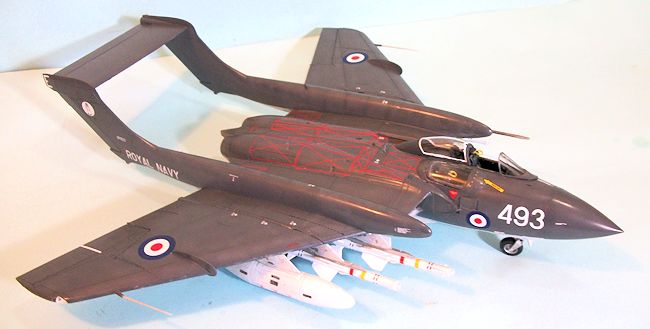 been a modeler-induced problem.
Overall, this was the best Airfix kit to be released
until the recent release of the even-better designed Gloster Javelin.
been a modeler-induced problem.
Overall, this was the best Airfix kit to be released
until the recent release of the even-better designed Gloster Javelin.
I opted to do mine with the dive brake and flaps
retracted.
Usually, deployed flaps are really only going to fit in the
deployed position, but in this case they fit closed, with only a little
reshaping necessary for the part that fit into the booms.
The kit offers the option of folding or extending the
wings, and the design is good enough that either choice will work without
problems.
I put three medium-sized fishweights in the nosecone, which
solved any tail-sitting without further problem.
At this point in the project, I managed a self-inflicted
wound when I managed to drop the completed canopy and find it the hard way -
Crrruuuunnnnch!
For the first time in over 50 years of building Airfix models, I
had to make use of Airfix’s legendary parts replacement service.
An e-mail to Hornby America resulted in an entire second
kit being sent as replacement within a week!
I have decided to use the Dynavector canopy on that one,
having used its canopy on this model, and will do a second Sea Vixen because I
like this kit so much.
One certainly must score Airfix and Hornby high in
customer service support.
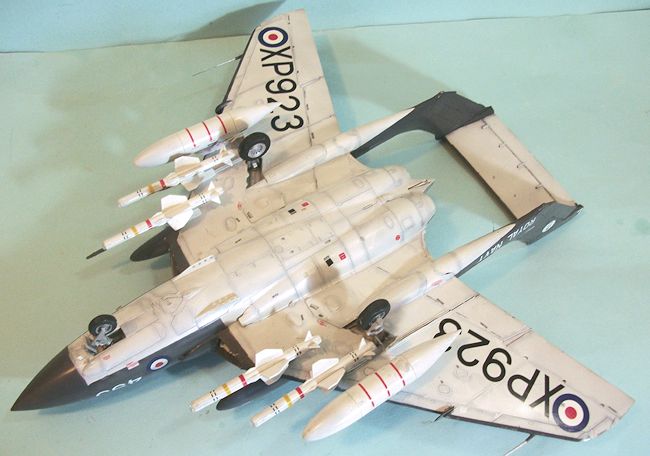 After pre-shading the model with Tamiya “NATO Black,” I painted the lower
surfaces with Tamiya gloss white.
I masked that and painted the upper surfaces with Tamiya
“Dark Grey,” which I post-faded a bit, the way airplanes look after a time at
sea.
When all was dry I gave the model a coat of Future.
After pre-shading the model with Tamiya “NATO Black,” I painted the lower
surfaces with Tamiya gloss white.
I masked that and painted the upper surfaces with Tamiya
“Dark Grey,” which I post-faded a bit, the way airplanes look after a time at
sea.
When all was dry I gave the model a coat of Future.
I used the kit
decals for the technical markings.
I had to do several applications of Solvaset to make the
red markings on the upper rear fuselage sit down without silvering, but
otherwise there was no problem.
I used the Xtradecals Sea Vixen decals 48089, to create
Sea Vixen XP923, 493/E, of 899 Squadron aboard HMS Hermes
in 1964.
I gave the model an overall coat of Xtracrylix Satin
clear varnish, then attached the landing gear and Red Top missiles.
I have thought
this airplane looked interesting ever since seeing photos of the prototype in my
first “serious” airplane book, William Green’s “All The World’s Aircraft, 1954.”
I thought the airplane definitely looked very cool when
I saw it in the flesh in Singapore in 1965.
The kit does not fail in achieving that look.
It is not difficult to build, and the result is a
good-looking model that is only exceeded in good design by its Javelin
stablemate.
Highly recommended.
Tom
Cleaver
December 2013
If you would like your product reviewed fairly and fairly quickly, please
contact
the editor or see other details in the
Note to
Contributors.
Back to the Main Page
Back to the Review
Index Page 2025



 At the time
of its introduction, the Sea Vixen attracted foreign interest, including West
Germany and Australia.
De Havilland was working on an improved with thin wings
when the British decided manned aircraft were obsolete in the 1957 Defense White
Paper.
Foreign interest evaporated and the supersonic version was canceled.
At the time
of its introduction, the Sea Vixen attracted foreign interest, including West
Germany and Australia.
De Havilland was working on an improved with thin wings
when the British decided manned aircraft were obsolete in the 1957 Defense White
Paper.
Foreign interest evaporated and the supersonic version was canceled. British
forces from Aden in 1967. Sea Vixens of 893 Squadron operated on HMS Victorious
during her epic far east cruise from 1965 to 1967 (Yours truly saw Victorious
and her Sea Vixens at Singapore shortly before my return to the United States
and return to civilian life).
The last Sea Vixen squadron was disbanded in 1972.
Several Sea Vixens were modified to D.3 missile target
drones, but were too expensive for such work and were used to train drone pilots
in flying aircraft by remote control.
Only five D.3 conversions were completed.
One has been restored for flight as G-CVIX and is a
regular airshow performer, the most complex civilian‑operated type on the UK
register until Vulcan XH558 was returned to the air.
British
forces from Aden in 1967. Sea Vixens of 893 Squadron operated on HMS Victorious
during her epic far east cruise from 1965 to 1967 (Yours truly saw Victorious
and her Sea Vixens at Singapore shortly before my return to the United States
and return to civilian life).
The last Sea Vixen squadron was disbanded in 1972.
Several Sea Vixens were modified to D.3 missile target
drones, but were too expensive for such work and were used to train drone pilots
in flying aircraft by remote control.
Only five D.3 conversions were completed.
One has been restored for flight as G-CVIX and is a
regular airshow performer, the most complex civilian‑operated type on the UK
register until Vulcan XH558 was returned to the air. been a modeler-induced problem.
Overall, this was the best Airfix kit to be released
until the recent release of the even-better designed Gloster Javelin.
been a modeler-induced problem.
Overall, this was the best Airfix kit to be released
until the recent release of the even-better designed Gloster Javelin. After pre-shading the model with Tamiya “NATO Black,” I painted the lower
surfaces with Tamiya gloss white.
I masked that and painted the upper surfaces with Tamiya
“Dark Grey,” which I post-faded a bit, the way airplanes look after a time at
sea.
When all was dry I gave the model a coat of Future.
After pre-shading the model with Tamiya “NATO Black,” I painted the lower
surfaces with Tamiya gloss white.
I masked that and painted the upper surfaces with Tamiya
“Dark Grey,” which I post-faded a bit, the way airplanes look after a time at
sea.
When all was dry I gave the model a coat of Future.